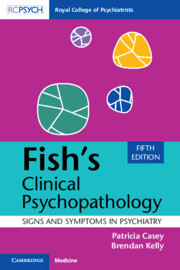383 results
The future of intergenerational transmission research: A prospective, three-generation approach
-
- Journal:
- Development and Psychopathology , First View
- Published online by Cambridge University Press:
- 04 June 2024, pp. 1-11
-
- Article
-
- You have access
- Open access
- HTML
- Export citation
Domain-specific associations between psychopathology and neurocognitive functioning
-
- Journal:
- Psychological Medicine , First View
- Published online by Cambridge University Press:
- 03 June 2024, pp. 1-11
-
- Article
-
- You have access
- Open access
- HTML
- Export citation
Chapter 14 - Phenomenological Psychopathology of Mood Disorders
-
-
- Book:
- Clinical Textbook of Mood Disorders
- Published online:
- 16 May 2024
- Print publication:
- 23 May 2024, pp 141-150
-
- Chapter
- Export citation
Impulsivity profiles across five harmonized longitudinal childhood preventive interventions and associations with adult outcomes
-
- Journal:
- Development and Psychopathology , First View
- Published online by Cambridge University Press:
- 24 April 2024, pp. 1-14
-
- Article
-
- You have access
- Open access
- HTML
- Export citation
Do dimensions of childhood adversity differ in their direct associations with youth psychopathology? A meta-analysis
-
- Journal:
- Development and Psychopathology , First View
- Published online by Cambridge University Press:
- 08 April 2024, pp. 1-31
-
- Article
-
- You have access
- Open access
- HTML
- Export citation
The influence of friendships on the mental health of maltreated youth: A pre-registered systematic review using a developmental psychopathology perspective
-
- Journal:
- Development and Psychopathology , First View
- Published online by Cambridge University Press:
- 27 March 2024, pp. 1-12
-
- Article
- Export citation
Contributions to inclusive and impactful development and psychopathology science: interrogating ecology-linked vulnerability and resilience opportunities
-
- Journal:
- Development and Psychopathology , First View
- Published online by Cambridge University Press:
- 25 March 2024, pp. 1-16
-
- Article
-
- You have access
- Open access
- HTML
- Export citation
Psychopathology as long-term sequelae of maltreatment and socioeconomic disadvantage: Neurocognitive development perspectives
-
- Journal:
- Development and Psychopathology , First View
- Published online by Cambridge University Press:
- 13 March 2024, pp. 1-12
-
- Article
-
- You have access
- Open access
- HTML
- Export citation
The future of neuroscience in developmental psychopathology
-
- Journal:
- Development and Psychopathology , First View
- Published online by Cambridge University Press:
- 06 March 2024, pp. 1-16
-
- Article
-
- You have access
- Open access
- HTML
- Export citation
How a defensive mindset develops from early adverse experiences and guides antisocial outcomes
-
- Journal:
- Development and Psychopathology , First View
- Published online by Cambridge University Press:
- 01 March 2024, pp. 1-7
-
- Article
-
- You have access
- Open access
- HTML
- Export citation
Chapter 12 - Position-Taking
-
-
- Book:
- Mental Health Research and Practice
- Published online:
- 01 February 2024
- Print publication:
- 08 February 2024, pp 197-209
-
- Chapter
- Export citation
Chapter 5 - New Perspectives in Eating Disorders
-
-
- Book:
- Mental Health Research and Practice
- Published online:
- 01 February 2024
- Print publication:
- 08 February 2024, pp 68-88
-
- Chapter
- Export citation
Non-human contributions to personality neuroscience: From fish through primates – a concluding editorial overview
-
- Journal:
- Personality Neuroscience / Volume 7 / 2024
- Published online by Cambridge University Press:
- 06 February 2024, e5
-
- Article
-
- You have access
- Open access
- HTML
- Export citation
9 - Disorders of Consciousness
-
- Book:
- Fish's Clinical Psychopathology
- Published online:
- 12 January 2024
- Print publication:
- 01 February 2024, pp 103-107
-
- Chapter
- Export citation
8 - Motor Disorders
-
- Book:
- Fish's Clinical Psychopathology
- Published online:
- 12 January 2024
- Print publication:
- 01 February 2024, pp 86-102
-
- Chapter
- Export citation
7 - Disorders of the Experience of Self
-
- Book:
- Fish's Clinical Psychopathology
- Published online:
- 12 January 2024
- Print publication:
- 01 February 2024, pp 80-85
-
- Chapter
- Export citation
4 - Disorders of Thought and Speech
-
- Book:
- Fish's Clinical Psychopathology
- Published online:
- 12 January 2024
- Print publication:
- 01 February 2024, pp 42-62
-
- Chapter
- Export citation
Maternal cognitive functioning and psychopathology predict quality of parent-child relationship in the context of substance use disorder: A 15-month longitudinal study
-
- Journal:
- Development and Psychopathology , First View
- Published online by Cambridge University Press:
- 29 January 2024, pp. 1-12
-
- Article
-
- You have access
- Open access
- HTML
- Export citation
The effects of life experiences and polygenic risk for depression on the development of positive and negative cognitive biases across adolescence: The CogBIAS hypothesis
-
- Journal:
- Development and Psychopathology , First View
- Published online by Cambridge University Press:
- 22 January 2024, pp. 1-10
-
- Article
-
- You have access
- Open access
- HTML
- Export citation

Fish's Clinical Psychopathology
- Signs and Symptoms in Psychiatry
-
- Published online:
- 12 January 2024
- Print publication:
- 01 February 2024



